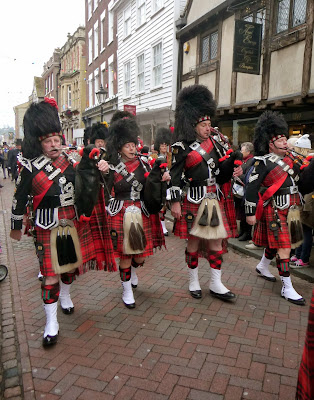Looking through the latest copy of the Radio Times I notice that there is a new television programme starting next Tuesday evening called 'Pilgrimage'. In the series, Simon Reeves a professional travel presenter apparently finds his spiritual side by following in the footsteps of pilgrims from Holy Island to Jerusalem. One of his pilgrimages is from St Omer in France to Santiago de Compostella.
I realise that I have been a little lapse lately about posting blogs about my camino, so reading this article I am encouraged (Translates as 'needing a good kick up the backside') to carry on writing about my adventures. Now where was I..........Oh yes, just leaving Belorado!
Today I had breakfast in the albergue, all you can eat for three euros. It sounds great although I personally can only eat so much croissant and sugary cakes first thing in the morning, so not such a great deal after all. All the American peregrinos are in their element as they are able to buy really good coffee in every bar at a very reasonable price, I on the other hand would love nothing better than a really good cup of English Breakfast Tea. As we all know you can't get good tea on the Continent.
I set off walking under an overcast sky, the sun was trying desperately hard to break through the murk but failing miserably. The first few kilometres were over fairly flat terrain until I came to the small town of Villafranca Montes De Oca. Here the trail took a steep ascent up a muddy path through woodland with fleeting glimpses of the adjoining hills and valleys. The scenery reminded me of the North Downs in Kent and Surrey.
After climbing to the top of the hill the route followed a long ridge through pine and birch forest for approximately eleven kilometres. In the past this was a wild and lonely place inhabited by bandits who used to prey on the peregrinos. Today It is still a very quiet and desolate place, except for the intermittent sound of traffic on the nearby motorway.


Approximately half way along the ridge in a very remote location I came across a large concrete memorial. This was the Monumento de los Caidos, a memorial to the Caidos (Fallen) who were executed here during the Spanish civil war in 1936 and a stark reminder of the futility of war. The mass grave contained the remains of men from the city of Burgos who were against the ruling Republican Government. Apparently they were kidnapped during the night and driven to this lonely site where they were murdered. It was an eerily haunted place, there was no sound of birdsong or animals, only the distant hum of traffic, I am not superstitious or easily spooked but I was glad that I was not there by myself.

After a long weary walk along this beautiful ridge I descended to the small hamlet of San Juan de Ortega a traditional pilgrim halt with a bar and hostel adjoining the church. The sun had finally come out so I purchased a beer from the bar and sat outside on a bench to eat my lunch. It was still quite early so I decided to walk a few kilometres to the albergue at another small hamlet called Age's (pronounced Arches).

Today was the first of May and a public holiday in Spain just like in the UK. My stomach was feeling much better, so that evening I joined a group of fellow peregrinos in celebrating the holiday with a delicious meal accompanied with numerous beers and wine. I slept like a log that night, totally oblivious to the sound of loud snoring coming from one of the bunks in my dormitory. In the morning I woke up to find that a Spanish family with young kids and a baby had spent the night in our dormitory. They were walking the camino in sections as part of their annual holidays and it was great to see that the children in particular appeared to be really enjoying their adventure.

















































